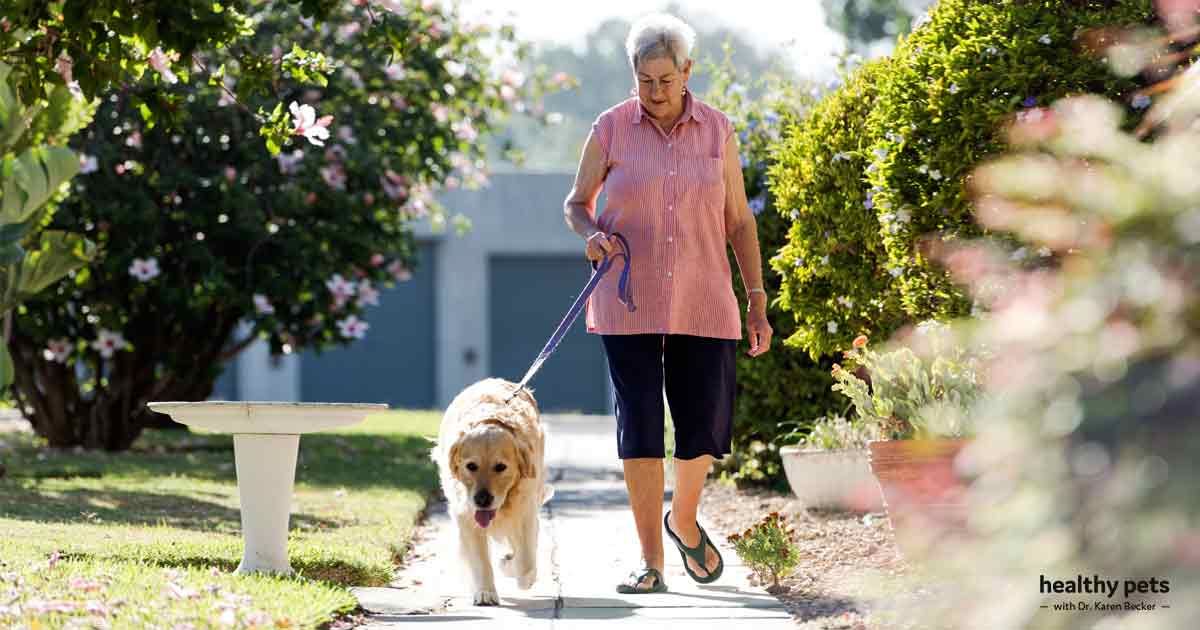Pat Smith, a retired teacher in her early 70s who is widowed, resides in Michigan with Brady, a mixed-breed pet (among the most intelligent she’’ s ever had, she states )embraced from a regional Humane Society.
““ He ’ s a terrific buddy, ” Smith informed TODAY “. “ He ’ s really active, however he truly is my finest pal. No matter where I enter my home, he follows me. He’’ s a genuine convenience to me.” 1
.
Like everyone with canine relative, Smith and Brady have their own reputable everyday regimen. Prior to each meal, Smith asks Brady to do ““ Circles, ” which is his hint to dance. He sits pleasantly waiting for her to put his bowl on the flooring and inform him ““ Ok.”
.
Throughout the day, Brady makes liberal usage of his doggy door to the backyard and checks in often with his mommy, expecting a fast video game of chase a walk or the ball outdoors. In the evening, he sees TELEVISION with her (from her lap), and when she offers the signal it’’ s time for bed, he makes one last journey through the doggy door to potty and after that zooms to his dog crate to await his nighttime reward.
Smith informed TODAY that her energetic little pet dog has actually motivated her to walk around a lot more, and she actually hopes other senior citizens will think about embracing pets. ““ I simply believe everyone ought to have an animal,” ” she stated.
. Pet-Owning Seniors Take Better Care of Themselves.
When she embraced Brady, due to the fact that she was over 60, Smith was entitled to a $100 discount rate from Pets for the Elderly , a nationwide not-for-profit that uses grants to getting involved shelters. Because its starting practically 30 years earlier, the company has actually paid a part of family pet adoption charges for almost 100,000 individuals aged 60 and up from more than 50 shelters in 34 states.
Recently, the group started providing a brand-new alternative to assist cover the expenses of regular veterinary care, surgical treatments, animal food, grooming and at home check outs for senior citizens with embraced animals. Susan Kurowski, 69, executive director of Pets for the Elderly, informed TODAY the non-profit was established ““ to assist elders feel much healthier and more linked through animals and to discover shelter pets and felines permanently houses.””
.
“ Now, specifically with COVID, bridging this entire seclusion space with friendship is going to reveal —– when we recall —– as being crucial to a lot of individuals’’ s psychological health,” ” she stated. “ And you wear ’ t need to live alone”to feel separated.”
.
According to Kurowski, family pets can be particularly useful to older individuals.
““ Seniors take much better care of themselves due to the fact that someone’’ s depending on them,” ” she stated. “ They keep a regular. They take their vitamins and their prescriptions on time since there’’ s somebody counting on them, which is so essential.””
. Pet Walking Seniors Meet Standardized Exercise Goals.
A research study released in 2017 concluded that senior citizens who are likewise pet dog moms and dads have the ability to fulfill worldwide acknowledged workout objectives as developed by the World Health Organization (WHO) through the basic act of strolling their canine buddies .2
A group of U.K. scientists compared 2 groups of 43 older grownups aged 65 to 81. One group included pet dog owners (typical canine age for the group was 8 years); the other group did not own canines. All the elders resided on their own, and members of the 2 groups were matched by gender, height, weight, health conditions, and strolling capabilities. About two-thirds were female, and the typical individual was at least a little obese.
The 2 groups were examined on their time invested strolling. They used displays to track their motions for 3 one-week durations throughout a year. The weeks were picked so the individuals’ ’ actions might be determined throughout various seasons and climate condition.
Past research study on this subject has actually counted on self-reporting by individuals regarding their level of exercise. Using activity displays in this research study supplied unbiased information on patterns and strength of exercise, along with durations of sitting.
.Pet Parents Walked More, Sat Less.
The scientists found the dog-owning group strolled approximately 22 minutes more daily than the dog-less group, which sufficed to fulfill both U.S. and worldwide workout suggestions for significant health advantages. And the additional workout the canine walkers got was ““ marching,” ” not “ simply dawdling, ” according to senior research study author Dr. Daniel Simon Mills.
The extra 147 minutes pet owners invested strolling at a moderate speed is simply 3 minutes under WHO’’ s suggestion of a minimum of 150 minutes of moderate to energetic weekly exercise. The U.S. Centers for Disease Control and Prevention (CDC) suggestion for grownups is a minimum of 150 minutes a week of moderate-intensity workout, or 75 minutes of vigorous-intensity aerobic activity a week.
The scientists likewise discovered that pet owners had less constant durations of taking a seat than non-dog owners.
Mills, who teaches veterinary behavioral medication at the University of Lincoln in England informed Reuters Health: ““ It ’ s extremely tough to discover any other intervention that produces this size of result. It’’ s excellent proof that canine ownership among the senior boosts exercise in a healthy and significant method.”” 3
.
Mills feels the research study shows that the workout advantages of pet dog ownership originate from having pet dogs, not from the concept that pet owners are more active to start with. The research study likewise verifies earlier research studies in which pet owners reported strolling more, at a moderate speed, than non-dog owners.
However, the scientists yielded that given that all the research study individuals were volunteers, they might have been more physically active than the basic population. Research study co-author Nancy Gee of the WALTHAM Centre for Pet Nutrition informed EurekAlert!:
” Our outcomes show that pet dog ownership might play an essential function in motivating older grownups to stroll more.
Ultimately, our research study will offer insights into how pet ownership might assist older individuals attain greater levels of exercise or keep their exercise levels for a longer amount of time, which might enhance their potential customers for a much better lifestyle, preserved or enhanced cognition, and maybe, even general durability.” 4
.Pet Dogs Offer Many Benefits to Retirees Beyond Exercise.
If you’’ re in great health and have the monetary ways to support an animal, there are unbelievable advantages of pet ownership , no matter your age. In addition to motivating you to remain active, pet dogs supply friendship and reduce solitude.
Another essential advantage is that pets end up being a centerpiece for our attention and need us to supply a specific quantity of structure to each day.
Dogs are likewise something to touch, which can be specifically helpful for older folks who live alone. Individuals obtain convenience from the existence of a pet dog on their lap or lying next to them. Canines likewise require to be looked after, and the act of supporting a family pet improves physical and psychological relaxation.
Dogs are, naturally, enjoyable and amusing, which can bring much-needed delight and laughter to the lives of elders. In addition, research studies reveal pet dog walkers are most likely to engage socially with other individuals when they’’ re out and about with their family pet.
. Canines Help Reduce Stress, Increase Optimism.Due to the fact that his existence pulls your attention away from yourself, #ppppp> Another factor a canine can have such an effective impact on your health is. Among the most reliable methods to decrease tension and boost sensations of optimism is to concentrate on something besides you. This can be a battle for individuals who notice their self-reliance escaping and who are likewise handling the physical restrictions of an aging body.
A little research study task carried out years earlier in California shows how the existence of an animal affects numerous crucial elements of life for individuals who are aging.5 Researchers tape-recorded the table talks of elderly people as they strolled their canines in a mobile house park.
All pet owners talked with and about their pets. They provided their pets guidelines and utilized their labels and names regularly. The pet dogs triggered their owners to remain in today minute. This is frequently hard for older individuals, who tend to believe typically about the previous or stress fanatically about the future.
Other individuals out for strolls spoken to the owners about their canines whether the pets existed or not. The discussions of canine owners often had to do with things in the here and now, whereas non-dog owners concentrated on stories about previous occasions.
Dog owners took two times as numerous everyday strolls usually as non-owners, and reported much less discontentment with their social, psychological and physical states. This reveals a healthy absence of self-absorption and a better, healthier, more enthusiastic outlook.
Mills provides some fantastic suggestions for senior citizens pondering pet ownership: ““ If you ’d like to get a canine, put on’’ t resent the reality you’’ re senior. It ’ s great for the pet, and it’’ s helpful for you, ” he states.
.
Read more: healthypets.mercola.com




Recent Comments